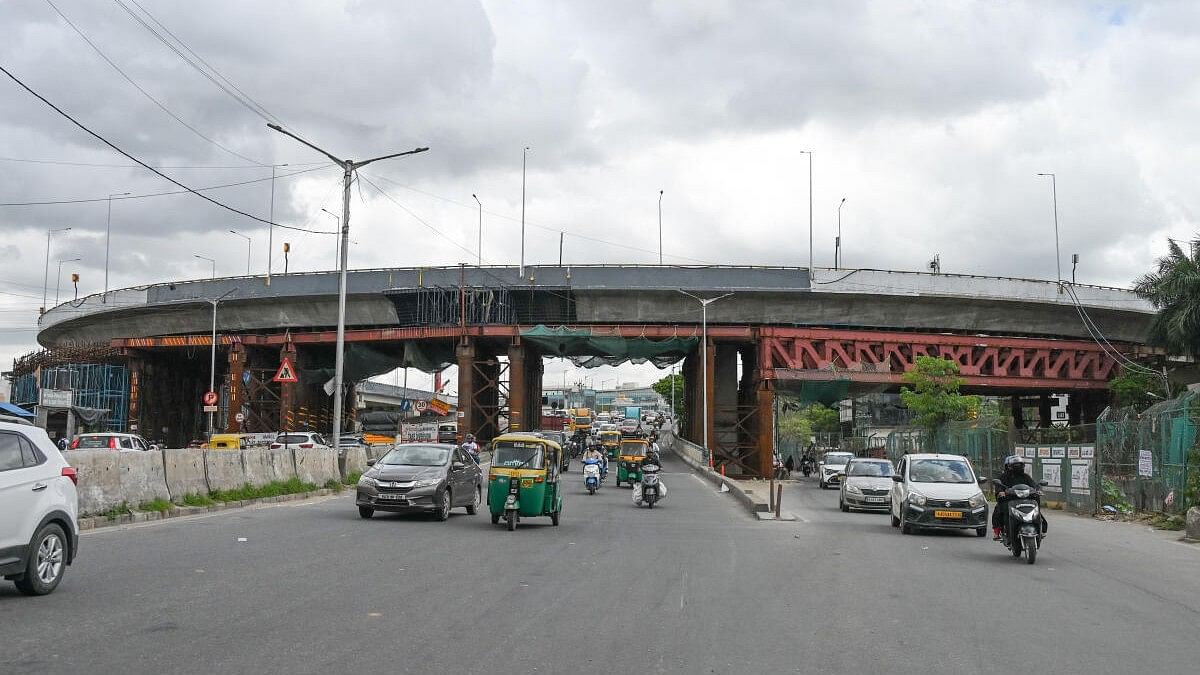
Double Deck Metro cum road fly over from Ragigudda to Silk Board by BMRCL in Bengaluru.
Credit: DH Photo/SK Dinesh
Bengaluru: South India's first road-metro flyover, ready for inauguration, promises to decongest the notorious Central Silk Board Junction in southern Bengaluru, with full benefits expected next year.
The 3.36-km flyover starts at the Ragigudda metro station and runs until Silk Board Junction below the Yellow Line, which is slated to open this December.
The flyover will have a total of five ramps. Work on two ramps (D and E) is still underway and is to complete in May 2025.
On July 5, DH drove through the unopened double-decker and found about a dozen workers giving it finishing touches.
The 2+2-lane flyover gives a smooth ride and has three U-turns. Three metro stations are situated midway (Jayadeva Hospital, BTM Layout and Silk Board Junction), but commuters cannot access them from the flyover.
Signage and road markings are completed, with small gaps being filled and traffic information boards being installed.
BL Yashavanth Chavan, Chief Public Relations Officer, Bangalore Metro Rail Corporation Limited (BMRCL), said the flyover was aimed at making the Silk Board Junction signal-free. "Providing access to metro stations will cause traffic jams," he told DH.
Chavan stressed that constructing ramps D and E was challenging because of the heavy traffic. "Some pillars have been erected, but we have to work in such a way as to minimise inconvenience to the public," he explained. "It's a brownfield project."
Sathees Kumar, Executive Engineer, BMRCL, said the flyover work started in September 2017 and encountered numerous challenges, particularly at the Jayadeva Hospital Junction.
T Mahadeva, Assistant Commissioner of Police (Traffic, Southeast), said the flyover would ease morning rush-hour congestion from Ragigudda and BTM Layout to Hosur Road and HSR Layout, reducing travel time from 30-45 minutes to five minutes. "This flyover will seamlessly connect western Bengaluru with the south," he told DH.
However, Mahadeva cautioned that the incomplete ramps D and E mean there would be little impact on evening rush-hour traffic, which is heavier in the opposite direction.
Vehicles from Hosur Road get a free left turn towards BTM Layout while those from HSR Layout proceed on Hosur Road via a service road, he added.
A survey by the traffic police two years ago found 46,000 vehicles pass through Silk Board Junction between 6 am and 10 pm daily, the officer noted.
Night ban?
The traffic police are thinking about closing the flyover from 10 pm to 5 am to prevent accidents. They also want a watchtower at the end of Ramp A to help with road accidents and emergencies.
In a discordant note, regular commuter Krishnan Kuppaswamy believes the new flyover will worsen traffic congestion from HSR Layout to Marathahalli, creating a "nightmare" at Silk Board Junction. He called for improving road conditions, regulating buses and removing road humps.